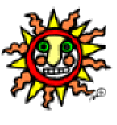DUALITY IN MEXICAN FOLK ART
The skeletons and skulls of Mexican folk art reflect the dualism
fundmental to the pre-Hispanic world view. Without duality in all
aspects of life, the universe loses its equilibrium. Animal and human
forms; masculine and feminine energies - all are needed. Of all these
balancing forces, perhaps none is more significant than that of life and
death.
Images expressing dualities abound in Mexican folk art. The
Nahuals of Oaxacan woodcarvers, for example, are supernatural beings
that transform back and forth from animal to human form and from human
to animal form. The belief in Nahuals is well-documented in
indigenous folk culture. However, if a survey were taken among Mexico's
folk artists, the combined imagery of life and death - la vida y la
muerte - would emerge as the most popular and pervasive theme.
 The iconographic image of the living and dead sharing a single body or
head remains a common visual theme in Mexican folk art. The reason is
simple: for the Mexican, life and death are part of the same linear
process. Birth leads into life, and life leads to death. Join the ends
of the process and the cycle of life is created.
The iconographic image of the living and dead sharing a single body or
head remains a common visual theme in Mexican folk art. The reason is
simple: for the Mexican, life and death are part of the same linear
process. Birth leads into life, and life leads to death. Join the ends
of the process and the cycle of life is created.
The roots of this duality are ancient and deep. The Borgia Codex
depicting pre-Hispanic life shows two gods: Quetzalcoatl, the god of
life who governs the earth and sky; and Mictlantlecuihtl, the god of the
underworld and keeper of the dead. They appear in profile, joined at the
spine. At first glance, they seem a single form. Two distinct shapes
then define themselves, one complementing the other and the two together
forming a complete whole. Each, we learn, needs the other to justify its
existence.
This information comes from:
http://www.mexconnect.com/mex_/travel/mjmendoza/mjmdiadelasmuertos.html |
 ¡En español!
¡En español!
 ¡En español!
¡En español!